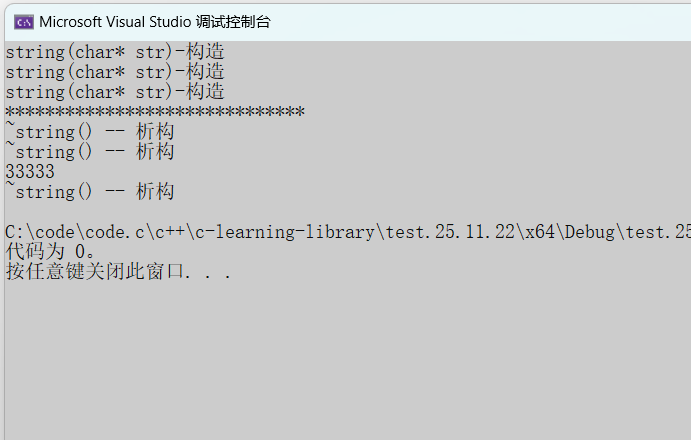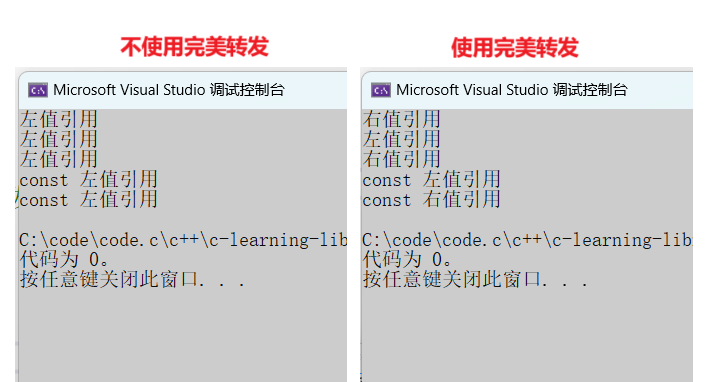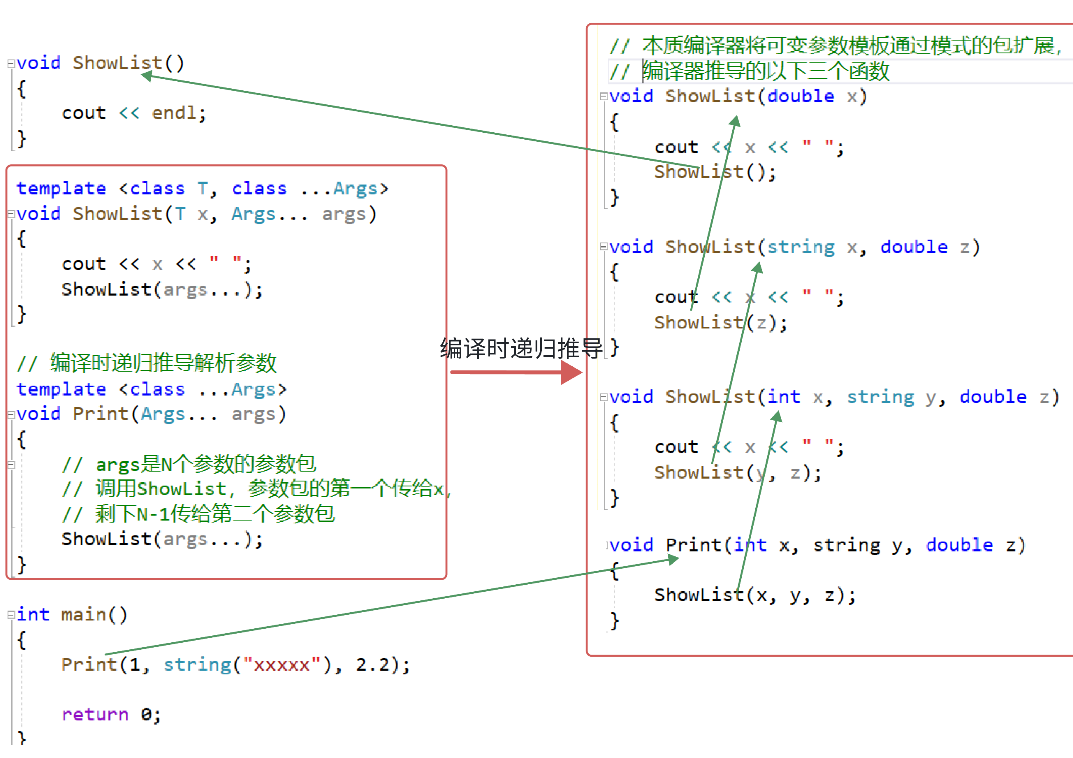1.列表初始化
1.1C++98传统的{}
C++98中⼀般数组和结构体可以⽤{}进⾏初始化
cpp
struct Point
{
int _x;
int _y;
};
int main()
{
int array1[] = { 1, 2, 3, 4, 5 };
int array2[5] = { 0 };
Point p = { 1, 2 };
return 0;
}1.2C++11中的{}
内置类型⽀持,⾃定义类型也⽀持,⾃定义类型本质是类型转换,中间会产⽣临时对象,最后优化
了以后变成直接构造。
{}初始化的过程中,可以省略掉=
C++11列表初始化的本意是想实现⼀个⼤统⼀的初始化⽅式,其次他在有些场景下带来的不少便利,如容器push/inset多参数构造的对象时,{}初始化会很⽅便
cpp
#include<iostream>
#include<vector>
using namespace std;
struct Point
{
int _x;
int _y;
};
class Date
{
public:
Date(int year = 1, int month = 1, int day = 1)
:_year(year)
, _month(month)
, _day(day)
{
cout << "Date(int year, int month, int day)" << endl;
}
Date(const Date& d)
:_year(d._year)
, _month(d._month)
, _day(d._day)
{
cout << "Date(const Date& d)" << endl;
}
private:
int _year;
int _month;
int _day;
};
int main()
{
// C++98⽀持的
int a1[] = { 1, 2, 3, 4, 5 };
int a2[5] = { 0 };
Point p = { 1, 2 };
// C++11⽀持的
// 内置类型⽀持
int x1 = { 2 };
// ⾃定义类型⽀持
// 这⾥本质是⽤{ 2025, 1, 1}构造⼀个Date临时对象
// 临时对象再去拷⻉构造d1,编译器优化后合⼆为⼀变成{ 2025, 1, 1}直接构造初始化
d1
// 运⾏⼀下,我们可以验证上⾯的理论,发现是没调⽤拷⻉构造的
Date d1 = { 2025, 1, 1 };
// 这⾥d2引⽤的是{ 2024, 7, 25 }构造的临时对象
const Date& d2 = { 2024, 7, 25 };
// 需要注意的是C++98⽀持单参数时类型转换,也可以不⽤{}
Date d3 = { 2025 };
Date d4 = 2025;
// 可以省略掉=
Point p1{ 1, 2 };
int x2{ 2 };
Date d6{ 2024, 7, 25 };
const Date& d7{ 2024, 7, 25 };
// 不⽀持,只有{}初始化,才能省略=
// Date d8 2025;
vector<Date> v;
v.push_back(d1);
v.push_back(Date(2025, 1, 1));
// ⽐起有名对象和匿名对象传参,这⾥{}更有性价⽐
v.push_back({ 2025, 1, 1 });
return 0;
}1.3std::initializer_list
C++11库中提出了⼀个std::initializer_list的类, auto il = { 10, 20, 30 }; // the
type of il is an initializer_list
这个类的本质是底层开⼀个数组,将数据拷⻉
过来,std::initializer_list内部有两个指针分别指向数组的开始和结束。
这是他的⽂档:initializer_list,std::initializer_list⽀持迭代器遍历。
容器⽀持⼀个std::initializer_list的构造函数,也就⽀持任意多个值构成的 {x1,x2,x3...} 进⾏
初始化。STL中的容器⽀持任意多个值构成的 {x1,x2,x3...} 进⾏初始化,就是通过std::initializer_list的构造函数⽀持的。
//STL中的容器都增加了⼀个initializer_list的构造
vector(initializer_list<value_type> il, const allocator_type& alloc = allocator_type());
list(initializer_list<value_type> il, const allocator_type& alloc =allocator_type());
map(initializer_list<value_type> il, const key_compare& comp =key_compare(), const allocator_type& alloc = allocator_type());
// 另外,容器的赋值也⽀持 initializer_list 的版本
vector& operator = (initializer_list<value_type> il);
map& operator = (initializer_list<value_type> il);
cpp
int main()
{
std::initializer_list<int> mylist;
mylist = { 10, 20, 30 };
cout << sizeof(mylist) << endl;
// 这⾥begin和end返回的值initializer_list对象中存的两个指针
// 这两个指针的值跟i的地址跟接近,说明数组存在栈上
int i = 0;
cout << mylist.begin() << endl;
cout << mylist.end() << endl;
cout << &i << endl;
// {}列表中可以有任意多个值
// 这两个写法语义上还是有差别的,第⼀个v1是直接构造,
// 第⼆个v2是构造临时对象+临时对象拷⻉v2+优化为直接构造
vector<int> v1({ 1,2,3,4,5 });
vector<int> v2 = { 1,2,3,4,5 };
const vector<int>& v3 = { 1,2,3,4,5 };
// 这⾥是pair对象的{}初始化和map的initializer_list构造结合到⼀起⽤了
map<string, string> dict = { {"sort", "排序"}, {"string", "字符串"} };
// initializer_list版本的赋值⽀持
v1 = { 10,20,30,40,50 };
return 0;
}2.引用和移动语义
C++98的C++语法中就有引⽤的语法,⽽C++11中新增了的 右值引⽤ 语法特性,C++11出来了,之前的引⽤就叫做 左值引⽤ 。无 论左值引用还是右值引用,都是给对象取别名
2.1左值和右值
左值是⼀个表⽰数据的表达式(如变量名或解引⽤的指针),⼀般是有持久状态,存储在内存中,可以获取它的地址 ,左值 可以出现 赋值符号的 左边 , 也可以出现在 赋值符号 右边
右值也是⼀个表⽰数据的表达式,要么是字⾯值常量、要么是表达式求值过程中创建的临时对象,右值 只能出现在 赋值符号的 右边 ,且不能取地址
int a = 10; //这里的a是一个左值,10是一个右值
int b = a; //这里的a和b都是左值,都可以取他的地址
cpp
int main()
{
// 左值:可以取地址
// 以下的p、b、c、*p、s、s[0]就是常⻅的左值
int* p = new int(0);
int b = 1;
const int c = b;
*p = 10;
string s("111111");
s[0] = 'x';
cout << &c << endl;
cout << (void*)&s[0] << endl;
// 右值:不能取地址
double x = 1.1, y = 2.2;
// 以下⼏个10、x + y、fmin(x, y)、string("11111")都是常⻅的右值
10;
x + y;
fmin(x, y);
string("11111");
//cout << &10 << endl;
//cout << &(x+y) << endl;
//cout << &(fmin(x, y)) << endl;
//cout << &string("11111") << endl;
return 0;
}2.2 左值引用和右值引用
左值引用和右值引用的语法:
//左值引用
Type& r1 = x;
//右值引用
Type&& r2 = y;
左值引⽤不能 直接引⽤右值,但是const左值引⽤可以引⽤右值
右值引⽤不能直接引⽤左值,但是右值引⽤可以引⽤move(左值)
move是库⾥⾯的⼀个函数模板,本质内部是进⾏强制类型转换,将左值变为右值
cpp
template <class _Ty>
remove_reference_t<_Ty>&& move(_Ty&& _Arg)
{ // forward _Arg as movable
return static_cast<remove_reference_t<_Ty>&&>(_Arg);
}变量表达式都是左值属性,也就意味着⼀个右值被右值引⽤绑定后,右值引⽤变量变量表达式的属性是左值
int b = 2; //2是右值,但b是左值
int&& c = 3; //3是右值,但c是左值
语法层⾯看,左值引⽤和右值引⽤都是取别名,不开空间。从汇编底层的⻆度看下⾯代码中r1和rr1
汇编层实现,底层都是⽤指针实现的
cpp
#include<iostream>
using namespace std;
int main()
{
// 左值:可以取地址
// 以下的p、b、c、*p、s、s[0]就是常⻅的左值
int* p = new int(0);
int b = 1;
const int c = b;
*p = 10;
string s("111111");
s[0] = 'x';
double x = 1.1, y = 2.2;
// 左值引⽤给左值取别名
int& r1 = b;
int*& r2 = p;
int& r3 = *p;
string& r4 = s;
char& r5 = s[0];
// 右值引⽤给右值取别名
int&& rr1 = 10;
double&& rr2 = x + y;
double&& rr3 = fmin(x, y);
string&& rr4 = string("11111");
// 左值引⽤不能直接引⽤右值,但是const左值引⽤可以引⽤右值
const int& rx1 = 10;
const double& rx2 = x + y;
const double& rx3 = fmin(x, y);
const string& rx4 = string("11111");
// 右值引⽤不能直接引⽤左值,但是右值引⽤可以引⽤move(左值)
int&& rrx1 = move(b);
int*&& rrx2 = move(p);
int&& rrx3 = move(*p);
string&& rrx4 = move(s);
string&& rrx5 = (string&&)s;
// b、r1、rr1都是变量表达式,都是左值
cout << &b << endl;
cout << &r1 << endl;
cout << &rr1 << endl;
// 这⾥要注意的是,rr1的属性是左值,所以不能再被右值引⽤绑定,除⾮move⼀下
int& r6 = r1;
// int&& rrx6 = rr1;
int&& rrx6 = move(rr1);
return 0;
}2.3延长生命周期
右值引⽤可⽤于为临时对象 延⻓⽣命周期 ,const 的左值引⽤也能延⻓临时对象⽣存期,但这些对象⽆法被修改
cpp
int main()
{
std::string s1 = "Test";
// std::string&& r1 = s1; // 错误:不能绑定到左值
const std::string& r2 = s1 + s1;
//const 的左值引⽤延⻓⽣存期
// r2 += "Test"; // 错误:不能通过到 const 的引⽤修改
std::string&& r3 = s1 + s1; // OK:右值引⽤延⻓⽣存期
r3 += "Test"; // OK:能通过到⾮ const 的引⽤修改
std::cout << r3 << '\n';
return 0;
}2.4左值和右值的参数匹配
C++98中,⼀个const左值引⽤作为参数的函数,那么实参传递左值和右值都可以匹配
C++11以后,分别重载左值引⽤、const左值引⽤、右值引⽤作为形参的f函数,那么实参是左值会
匹配f(左值引⽤),实参是const左值会匹配f(const 左值引⽤),实参是右值会匹配f(右值引⽤)。
需要强调,右值引⽤变量在⽤于表达式时属性是左值
cpp
#include<iostream>
using namespace std;
void f(int& x)
{
std::cout << "左值引⽤重载 f(" << x << ")\n";
}
void f(const int& x)
{
std::cout << "到 const 的左值引⽤重载 f(" << x << ")\n";
}
void f(int&& x)
{
std::cout << "右值引⽤重载 f(" << x << ")\n";
}
int main()
{
int i = 1;
const int ci = 2;
f(i); // 调⽤ f(int&)
f(ci); // 调⽤ f(const int&)
f(3); // 调⽤ f(int&&),如果没有 f(int&&) 重载则会调⽤ f(const int&)
f(std::move(i)); // 调⽤ f(int&&)
// 右值引⽤变量在⽤于表达式时是左值
int&& x = 1;
f(x); // 调⽤ f(int& x)
f(std::move(x)); // 调⽤ f(int&& x)
return 0;
}2.5右值引用和移动语义的使用场景
使用右值引用可以实现移动构造和移动赋值
2.5.1移动构造和移动赋值
移动构造函数是⼀种构造函数,类似拷⻉构造函数,移动构造函数要求第⼀个参数是该类类型的引
⽤,但是不同的是要求这个参数是右值引⽤,如果还有其他参数,额外的参数必须有缺省值
移动赋值是⼀个赋值运算符的重载,他跟拷⻉赋值构成函数重载,类似拷⻉赋值函数,移动赋值函
数要求第⼀个参数是该类类型的引⽤,但是不同的是要求这个参数是右值引⽤
对于像string/vector这样的深拷⻉的类或者包含深拷⻉的成员变量的类, 移动构造和移动赋值才有意义 ,因为移动构造和移动赋值的本质是要" 窃取 "引⽤的 右值对象的资源,提⾼效率,⽽不是像拷⻉构造和拷⻉赋值那样去拷⻉资源
演示移动构造和移动赋值:
cpp
class string
{
public:
string(const char* str = "")
:_size(strlen(str))
, _capacity(_size)
{
cout << "string(char* str)-构造" << endl;
_str = new char[_capacity + 1];
strcpy(_str, str);
}
string(const string& s)
:_str(nullptr)
{
cout << "string(const string& s) -- 拷⻉构造" << endl;
reserve(s._capacity);
for (auto ch : s)
{
push_back(ch);
}
}
// 移动构造
string(string&& s)
{
cout << "string(string&& s) -- 移动构造" << endl;
swap(s);
}
string& operator=(const string& s)
{
cout << "string& operator=(const string& s) -- 拷⻉赋值" <<
endl;
if (this != &s)
{
_str[0] = '\0';
_size = 0;
reserve(s._capacity);
for (auto ch : s)
{
push_back(ch);
}
}
return *this;
}
// 移动赋值
string& operator=(string&& s)
{
cout << "string& operator=(string&& s) -- 移动赋值" << endl;
swap(s);
return *this;
}
~string()
{
cout << "~string() -- 析构" << endl;
delete[] _str;
_str = nullptr;
}
private:
char* _str = nullptr;
size_t _size = 0;
size_t _capacity = 0;
};int main()
{
string s1("xxxxx");
// 拷⻉构造
string s2 = s1;
// 构造+移动构造,优化后直接构造
string s3 = bit::string("yyyyy");
// 移动构造
string s4 = move(s1);
cout << "******************************" << endl;
return 0;
}
注意:现在的编译器会在一些场景下会自行优化:
cpp
namespace csl
{
class string
{
public:
typedef char* iterator;
typedef const char* const_iterator;
iterator begin()
{
return _str;
}
iterator end()
{
return _str + _size;
}
const_iterator begin() const
{
return _str;
}
const_iterator end() const
{
return _str + _size;
}
string(const char* str = "")
:_size(strlen(str))
, _capacity(_size)
{
cout << "string(char* str)-构造" << endl;
_str = new char[_capacity + 1];
strcpy(_str, str);
}
void swap(string& s)
{
::swap(_str, s._str);
::swap(_size, s._size);
::swap(_capacity, s._capacity);
}
string(const string& s)
:_str(nullptr)
{
cout << "string(const string& s) -- 拷⻉构造" << endl;
reserve(s._capacity);
for (auto ch : s)
{
push_back(ch);
}
}
string& operator=(const string& s)
{
cout << "string& operator=(const string& s) -- 拷⻉赋值" <<
endl;
if (this != &s)
{
_str[0] = '\0';
_size = 0;
reserve(s._capacity);
for (auto ch : s)
{
push_back(ch);
}
}
return *this;
}
~string()
{
cout << "~string() -- 析构" << endl;
delete[] _str;
_str = nullptr;
}
char& operator[](size_t pos)
{
assert(pos < _size);
return _str[pos];
}
void reserve(size_t n)
{
if (n > _capacity)
{
char* tmp = new char[n + 1];
if (_str)
{
strcpy(tmp, _str);
delete[] _str;
}
_str = tmp;
_capacity = n;
}
}
void push_back(char ch)
{
if (_size >= _capacity)
{
size_t newcapacity = _capacity == 0 ? 4 : _capacity *
2;
reserve(newcapacity);
}
_str[_size] = ch;
++_size;
_str[_size] = '\0';
}
string& operator+=(char ch)
{
push_back(ch);
return *this;
}
const char* c_str() const
{
return _str;
}
size_t size() const
{
return _size;
}
private:
char* _str = nullptr;
size_t _size = 0;
size_t _capacity = 0;
};
string addStrings(string num1, string num2)
{
string str;
int end1 = num1.size() - 1, end2 = num2.size() - 1;
int next = 0;
while (end1 >= 0 || end2 >= 0)
{
int val1 = end1 >= 0 ? num1[end1--] - '0' : 0;
int val2 = end2 >= 0 ? num2[end2--] - '0' : 0;
int ret = val1 + val2 + next;
next = ret / 10;
ret = ret % 10;
str += ('0' + ret);
}
if (next == 1)
str += '1';
reverse(str.begin(), str.end());
cout << "******************************" << endl;
return str;
}
}
int main()
{
csl::string ret = csl::addStrings("11111", "22222");
cout << ret.c_str() << endl;
return 0;
}完全不优化情况下应该是:

vs2022下会直接将str对象的构造,str拷⻉构造临时对象,临时对象拷⻉构造ret对象,合三为⼀,变为直接构造:
vs2022运行结果:

2.6类型分类
C++11以后,进⼀步对类型进⾏了划分,右值被划分纯右值和将亡值
纯右值:字⾯值常量、求值结果、临时对象
将亡值:返回右值引⽤的函数的调⽤表达式、转换为右值引⽤的转换函数的调⽤表达

2.7引用折叠
C++ 通过模板或 typedef 中的类型操作可以构成引⽤的引⽤
右值引⽤的右值引⽤ 折叠成 右值引⽤ ,所有 其他组合 均折叠成 左值引⽤
typedef int& lref;
typedef int&& rref;
int n = 0;
lref& r1 = n; // r1 的类型是 int&,左值引用
lref&& r2 = n; // r2 的类型是 int&,左值引用
rref& r3 = n; // r3 的类型是 int&,左值引用
rref&& r4 = 1; // r4 的类型是 int&&,右值引用
2.8完美转发
变量表达式都是左值属性,那么我们把 t 传递给下⼀层函数,那么匹配的都是左值引⽤版本的函数。想要保持t对象的属性,就需要使⽤ 完美转发 forward
cpp
void Fun(int& x) { cout << "左值引用" << endl; }
void Fun(const int& x) { cout << "const 左值引用" << endl; }
void Fun(int&& x) { cout << "右值引用" << endl; }
void Fun(const int&& x) { cout << "const 右值引用" << endl; }
template<class T>
void Function(T&& t)
{
Fun(t);
//Fun(forward<T>(t)); //使用完美转发
}
int main()
{
Function(10); // 右值
int a;
Function(a); // 左值
Function(std::move(a)); // 右值
const int b = 8;
Function(b); // const 左值
Function(std::move(b)); // const 右值
return 0;
}
完美转发的本质就是函数模板
template <class _Ty>
_Ty&& forward(remove_reference_t<_Ty>& _Arg) noexcept
{
return static_cast<_Ty&&>(_Arg);
}
3.可变参数模板
可变参数模板,也就是说⽀持可变数量参数的函数模板和类模板
可变数目的参数被称为参数包,存在两种参数包:模板参数包、函数参数包
template <class ...Args> void Func(Args... args) {}
template <class ...Args> void Func(Args&... args) {}
template <class ...Args> void Func(Args&&... args) {}
⽤省略号来指出⼀个模板参数或函数参数的表⽰⼀个包,在模板参数列表中,class...或 typename...指出接下来的参数表⽰零或多个类型列表;在函数参数列表中,类型名后⾯跟...指出
接下来表⽰零或多个形参对象列表;函数参数包可以⽤左值引⽤或右值引⽤表⽰,跟前⾯普通模板
⼀样,每个参数实例化时遵循引⽤折叠规则
sizeof...计算参数包中参数的个数:
cpp
#include<iostream>
using namespace std;
template <class ...Args>
void Print(Args&&... args)
{
cout << sizeof...(args) << endl;
}
int main()
{
double x = 2.2;
Print(); // 包⾥有0个参数
Print(1); // 包⾥有1个参数
Print(1, string("xxxxx")); // 包⾥有2个参数
Print(1.1, string("xxxxx"), x); // 包⾥有3个参数
return 0;
}3.1包扩展
当扩展⼀个包时,要提供⽤于每个扩展元素的模式
扩展⼀个包就是将它分解为构成的元素,对每个元素应⽤模式,获得扩展后的列表
cpp
void ShowList()
{
// 编译器时递归的终⽌条件,参数包是0个时,直接匹配这个函数
cout << endl;
}
template <class T, class ...Args>
void ShowList(T x, Args... args)
{
cout << x << " ";
// args是N个参数的参数包
// 调⽤ShowList,参数包的第⼀个传给x,剩下N-1传给第⼆个参数包
ShowList(args...);
}
// 编译时递归推导解析参数
template <class ...Args>
void Print(Args... args)
{
ShowList(args...);
}
int main()
{
Print();
Print(1);
Print(1, string("xxxxx"));
Print(1, string("xxxxx"), 2.2);
return 0;
}编译时的细节:

3.2 emplace系列接口
C++11以后STL容器新增了empalce系列的接⼝,均为 模板可变参数 ,功能上兼容push和insert系列
假设容器为container<T>,empalce还⽀持直接插⼊构造T对象的参数,有些场景会更⾼效⼀些,
可以直接在容器空间上构造T对象,使用与insert、push类似
4. lambda
lambda 表达式本质是⼀个 匿名函数对象 ,跟普通函数不同的是他可以定义在函数内部。
lambda 表达式语法使⽤层⽽⾔没有类型,⼀般是⽤auto或者模板参数定义的对象去接收lambda 对象
4.1 lambda语法
lambda的语法:
capture-list\] (parameters) -\> return type { function boby }
lambda是一个匿名函数对象,它与函数有相似之处,也有不同:
capture-list\]:捕捉列表,能够捕捉上下⽂中的变量供 lambda 函数使用
(parameters) :参数列表,如果不需要参数传递,则可以连 同()⼀起省略
-\>return type :返回值类型,⽤追踪返回类型形式声明函数的返回值类型,没有返回值时此部分可省略
{function boby} :函数体,跟普通函数完全类似,在该函数体内,还可以使⽤所有捕获到的变量,任何时候花括号{}都不能省略
```cpp
int main()
{
// ⼀个简单的lambda表达式
auto add1 = [](int x, int y)->int {return x + y; };
cout << add1(2, 2) << endl;
// 1、捕捉为空也不能省略
// 2、参数为空可以省略
// 3、返回值可以省略,可以通过返回对象⾃动推导
// 4、函数题不能省略
auto func1 = []
{
cout << "lambda" << endl;
return 0;
};
func1();
int a = 0, b = 1;
auto swap1 = [](int& x, int& y)
{
int tmp = x;
x = y;
y = tmp;
};
swap1(a, b);
cout << a << ":" << b << endl;
return 0;
}
```
### 4.2 lambda的应用
lambda可用于调用对象,相比于函数指针和仿函数对象,lambda更方便;还可用于线程中定义线程的执⾏函数逻辑,智能指针中定制删除器等
下面为lambda在比较大小的使用:
```cpp
#include